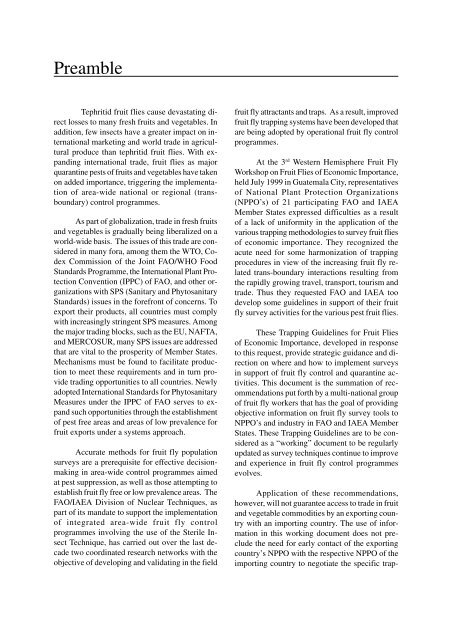Fruit fly trapping guide - IAEA Publications - International Atomic ...
Fruit fly trapping guide - IAEA Publications - International Atomic ...
Fruit fly trapping guide - IAEA Publications - International Atomic ...
Create successful ePaper yourself
Turn your PDF publications into a flip-book with our unique Google optimized e-Paper software.
Preamble<br />
Tephritid fruit flies cause devastating direct<br />
losses to many fresh fruits and vegetables. In<br />
addition, few insects have a greater impact on international<br />
marketing and world trade in agricultural<br />
produce than tephritid fruit flies. With expanding<br />
international trade, fruit flies as major<br />
quarantine pests of fruits and vegetables have taken<br />
on added importance, triggering the implementation<br />
of area-wide national or regional (transboundary)<br />
control programmes.<br />
As part of globalization, trade in fresh fruits<br />
and vegetables is gradually being liberalized on a<br />
world-wide basis. The issues of this trade are considered<br />
in many fora, among them the WTO, Codex<br />
Commission of the Joint FAO/WHO Food<br />
Standards Programme, the <strong>International</strong> Plant Protection<br />
Convention (IPPC) of FAO, and other organizations<br />
with SPS (Sanitary and Phytosanitary<br />
Standards) issues in the forefront of concerns. To<br />
export their products, all countries must comply<br />
with increasingly stringent SPS measures. Among<br />
the major trading blocks, such as the EU, NAFTA,<br />
and MERCOSUR, many SPS issues are addressed<br />
that are vital to the prosperity of Member States.<br />
Mechanisms must be found to facilitate production<br />
to meet these requirements and in turn provide<br />
trading opportunities to all countries. Newly<br />
adopted <strong>International</strong> Standards for Phytosanitary<br />
Measures under the IPPC of FAO serves to expand<br />
such opportunities through the establishment<br />
of pest free areas and areas of low prevalence for<br />
fruit exports under a systems approach.<br />
Accurate methods for fruit <strong>fly</strong> population<br />
surveys are a prerequisite for effective decisionmaking<br />
in area-wide control programmes aimed<br />
at pest suppression, as well as those attempting to<br />
establish fruit <strong>fly</strong> free or low prevalence areas. The<br />
FAO/<strong>IAEA</strong> Division of Nuclear Techniques, as<br />
part of its mandate to support the implementation<br />
of integrated area-wide fruit <strong>fly</strong> control<br />
programmes involving the use of the Sterile Insect<br />
Technique, has carried out over the last decade<br />
two coordinated research networks with the<br />
objective of developing and validating in the field<br />
fruit <strong>fly</strong> attractants and traps. As a result, improved<br />
fruit <strong>fly</strong> <strong>trapping</strong> systems have been developed that<br />
are being adopted by operational fruit <strong>fly</strong> control<br />
programmes.<br />
At the 3 rd Western Hemisphere <strong>Fruit</strong> Fly<br />
Workshop on <strong>Fruit</strong> Flies of Economic Importance,<br />
held July 1999 in Guatemala City, representatives<br />
of National Plant Protection Organizations<br />
(NPPO’s) of 21 participating FAO and <strong>IAEA</strong><br />
Member States expressed difficulties as a result<br />
of a lack of uniformity in the application of the<br />
various <strong>trapping</strong> methodologies to survey fruit flies<br />
of economic importance. They recognized the<br />
acute need for some harmonization of <strong>trapping</strong><br />
procedures in view of the increasing fruit <strong>fly</strong> related<br />
trans-boundary interactions resulting from<br />
the rapidly growing travel, transport, tourism and<br />
trade. Thus they requested FAO and <strong>IAEA</strong> too<br />
develop some <strong>guide</strong>lines in support of their fruit<br />
<strong>fly</strong> survey activities for the various pest fruit flies.<br />
These Trapping Guidelines for <strong>Fruit</strong> Flies<br />
of Economic Importance, developed in response<br />
to this request, provide strategic guidance and direction<br />
on where and how to implement surveys<br />
in support of fruit <strong>fly</strong> control and quarantine activities.<br />
This document is the summation of recommendations<br />
put forth by a multi-national group<br />
of fruit <strong>fly</strong> workers that has the goal of providing<br />
objective information on fruit <strong>fly</strong> survey tools to<br />
NPPO’s and industry in FAO and <strong>IAEA</strong> Member<br />
States. These Trapping Guidelines are to be considered<br />
as a “working” document to be regularly<br />
updated as survey techniques continue to improve<br />
and experience in fruit <strong>fly</strong> control programmes<br />
evolves.<br />
Application of these recommendations,<br />
however, will not guarantee access to trade in fruit<br />
and vegetable commodities by an exporting country<br />
with an importing country. The use of information<br />
in this working document does not preclude<br />
the need for early contact of the exporting<br />
country’s NPPO with the respective NPPO of the<br />
importing country to negotiate the specific trap-













